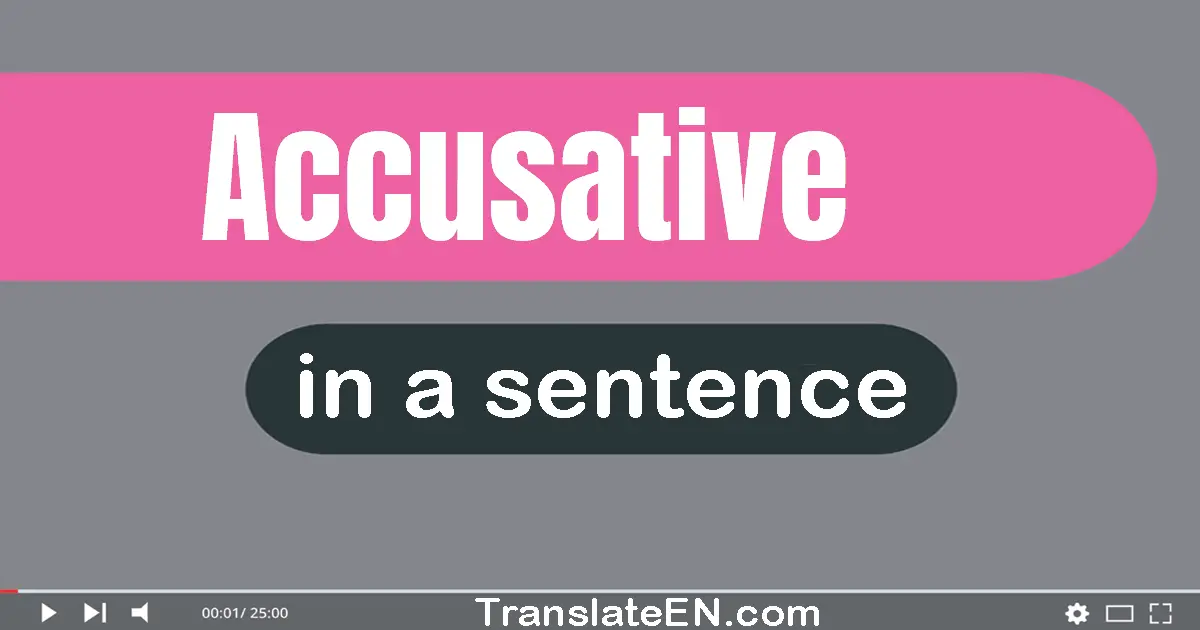Accusative in a sentence

(1) The accusative form of the noun cat is cat.
(2) The accusative form of the noun dog is dog.
(3) The accusative form of the noun book is book.
(4) The accusative form of the noun apple is apple.
(5) The accusative form of the noun table is table.
(6) The a-stem noun declined in the accusative case.
(7) The accusative ending for plural nouns in German is -e.
(8) Dich is the accusative form of the pronoun du in German.
(9) The accusative ending for neuter nouns in Russian is -o.
(10) The accusative case is the fourth case in the declinals.
Accusative sentence
(11) The accusative ending for feminine nouns in Spanish is -a.
(12) The accusative ending for masculine nouns in German is -en.
(13) The accusative case is also used with certain prepositions.
(14) The accusative case is also used after certain prepositions.
(15) The accusative pronoun me is used when referring to oneself.
(16) The accusative pronoun him is used when referring to a male person.
(17) The accusative case is used to indicate the direct object of a verb.
(18) The declinational endings of this noun change in the accusative case.
(19) The accusative pronoun her is used when referring to a female person.
(20) The accusative pronoun you is used when referring to a single person.
Accusative make sentence
(21) The accusative pronoun them is used when referring to multiple people.
(22) The accusative pronoun it is used when referring to a non-living thing.
(23) The accusative pronoun them is used when referring to a group of people.
(24) The accusative pronoun us is used when referring to ourselves and others.
(25) In German, the accusative case is used to indicate motion towards a place.
(26) The accusative case is used to show the duration of time in some languages.
(27) In Latin, nouns in the accusative case often receive the action of the verb.
(28) The desinent of the noun in the accusative case indicates the direct object.
(29) In Russian, the accusative case is used to indicate the direct object of a verb.
(30) In Spanish, the accusative case is used to indicate the direct object of a verb.
Sentence of accusative
(31) The accusative case is used to express motion through a place in some languages.
(32) The case system in Arabic includes three cases: nominative, accusative, and genitive.
(33) The case system in Ancient Hebrew had three cases: nominative, accusative, and genitive.
(34) The accusative case is important for understanding sentence structure in many languages.
(35) The case system in Old Norse had four cases: nominative, accusative, dative, and genitive.
(36) The case system in Old Saxon had four cases: nominative, accusative, dative, and genitive.
(37) Ergative languages can have different pronoun systems than nominative-accusative languages.
(38) Ergativity is often contrasted with nominative-accusative alignment in linguistic typology.
(39) The declinational endings of this noun are the same in the nominative and accusative cases.
(40) The case system in German includes four cases: nominative, accusative, dative, and genitive.
Accusative meaningful sentence
(41) The case system in Old Persian had four cases: nominative, accusative, genitive, and dative.
(42) Ergative languages can have different agreement patterns than nominative-accusative languages.
(43) Ergative languages can have different word order patterns than nominative-accusative languages.
(44) The case system in Korean is relatively simple, with only two cases: nominative and accusative.
(45) The case system in Icelandic includes four cases: nominative, accusative, dative, and genitive.
(46) The case system in Japanese is relatively simple, with only two cases: nominative and accusative.
(47) The case system in Old Irish had five cases: nominative, accusative, genitive, dative, and vocative.
(48) Ergative-absolutive languages have a different alignment pattern than nominative-accusative languages.
(49) Ergative constructions can be challenging to understand for speakers of nominative-accusative languages.
(50) The case system in Korean is relatively simple, with only three cases: nominative, accusative, and genitive.
Accusative sentence examples
(51) The case system in Ancient Greek includes five cases: nominative, genitive, dative, accusative, and vocative.
(52) The case system in Turkish includes six cases: nominative, accusative, dative, locative, ablative, and genitive.
(53) The case system in Icelandic is highly inflected, with four cases: nominative, accusative, dative, and genitive.
(54) The case system in Russian includes nominative, genitive, dative, accusative, instrumental, and prepositional cases.
(55) Ergativity is often contrasted with nominative-accusative alignment, which is more common in Indo-European languages.
(56) The ablative case is one of the most important cases in Latin grammar, along with the nominative and accusative cases.
(57) The case system in Old High German had six cases: nominative, accusative, dative, genitive, instrumental, and locative.
(58) The case system in Czech includes seven cases: nominative, genitive, dative, accusative, instrumental, locative, and vocative.
(59) The case system in Czech includes seven cases: nominative, genitive, dative, accusative, vocative, locative, and instrumental.
(60) The case system in Polish includes seven cases: nominative, genitive, dative, accusative, instrumental, locative, and vocative.
(61) The case system in Lithuanian includes seven cases: nominative, genitive, dative, accusative, instrumental, locative, and vocative.
(62) The case system in Old Church Slavonic had seven cases: nominative, accusative, genitive, dative, instrumental, locative, and vocative.
(63) The case system in Old Church Slavonic includes seven cases: nominative, genitive, dative, accusative, instrumental, locative, and vocative.
The word usage examples above have been gathered from various sources to reflect current and historical usage of the word Accusative. They do not represent the opinions of TranslateEN.com.
